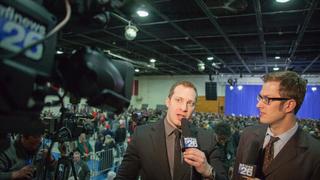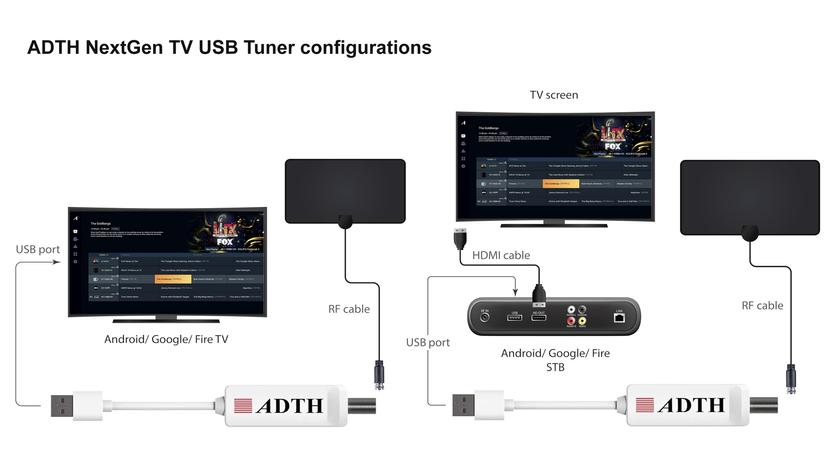LPTV Entrepreneur Weighs In
CADILLAC, MICH.—Donald Trump made a campaign visit to Cadillac in March—the first visit by a presidential candidate since George Wallace campaigned in 1972.

Eric Wotila (right) and Political Correspondent Benjamin Arie report from a Donald Trump rally.
Like all of the candidate’s events, Trump’s visit drew enormous crowds, far bigger than any venue in the town of 10,000 could hold. All the local media plus several national outlets, including CNN and Fox News, were in attendance. However, of all the broadcast media at the event, only one TV station, WMNN-LD, broadcast the rally live and in its entirety.
I built WMNN five years ago, after being interested in TV for as long as I can remember. I got my start in the industry by running a camera for football games at the local public access station at the age of 13. By the time I was 16, I had an internship in the news department at the local Fox affiliate—a small enough station that the running joke was, “go send the intern to cover the fire.” I would regularly be put on assignment due to the station’s small staff.
By the time I was 18, I had convinced Charter to launch “Local Edition,” a local news cut-in on CNN Headline News, in an underutilized time slot provided by the network. I partnered with the cable company to produce a five-minute local news cut-in, which was inserted once every hour on the cable system in the Cadillac area.
When the recession struck, the plug was pulled on “Local Edition.” Around the same time the newscast was cancelled, the Federal Communications Commission opened their 2009 low-power TV filing window. I applied for a construction permit to build a station in Cadillac.
That CP was granted in December 2010, and WMNN—a 425 W, digital LPTV station operating on RF Channel 14 (with a virtual channel number of 26, due to PSIP conflict with the local PBS station), signed on with its first newscast two months later. I was 22.
OFF AND RUNNING
When it signed on, the station was staffed by three volunteers who believed in the project and would stop by its studio after their day jobs to produce daily segments, such as news headlines and weather. Over the last five years, the station has grown to employ a full-time staff of five as well as numerous part-timers. On our primary channel, we maintain a 24/7 local news format, occasionally cutting away from news for other local programming, like multi-camera, HD productions of local sports games from our three live trucks. We also broadcast five subchannels: Antenna TV, Laff, Grit, Escape and Buzzr, which, combined with our flagship, HD local news channel, make up one-third of all the broadcast channels available in the market, despite the other content coming from 10 different transmitters.

Chief Photojournalist Wyatt VanDuinen and Photojournalist Dakota Pike
As WMNN has grown, we’ve purchased our own building and increased our power to 1.97 kW. We’ve even moved from rented space on a local tower to our own, which was constructed last year and has space for other tenants. A local full-power radio station is scheduled to move to it in the near future.
Our model has been so successful that I was hired to consult with another LPTV station group. I’ve helped that group launch a network of local news stations, and I plan to launch additional stations of my own in the future.
This entire business was made possible by low-power television, but its existence is threatened by the increasing amount of spectrum that could very well be reallocated to commercial wireless providers in this year’s spectrum auction.
When the spectrum auction was announced—just a couple of years after the DTV transition was completed and the FCC opened a filing window encouraging new LPTV stations to sign on—I was extremely concerned about the possible implications for the future of our industry. Of course, the amount of spectrum being reallocated has always been a moving target, but for quite some time now, a clearing target of Channel 38 on up seems to have been a pretty commonly accepted number tossed around.
When the FCC announced a clearing target of 126 MHz on April 29, my concerns grew, as did those of many LPTV operators.
UNCERTAIN FUTURE
We’re in a small market, with only eight full-power transmitters in a 25 county area. Of those, only two are on channels above 38. However, if Channel 29 on up is cleared, as many as half of the stations in our market will need to move to new channels, and that’s assuming nobody conflicts with the new channel numbers of stations in nearby markets.
An even bigger concern is what happens after this year’s spectrum auction. When the digital transition occurred in 2009, Channels 51-69 were reallocated. Now, just a few years later, we’re looking at losing Channels 30-51. What’s stopping the FCC from deciding in a couple more years that they need Channels 14-29 as well?
While I own a construction permit for another LPTV station and have plans to acquire more, those plans for further expansion have been put on hold as the spectrum auction moves forward.
I’d love to do what we’re doing in Cadillac in other markets—and I’m eager to get more stations on-air—but when we’re being constantly threatened with the possibility of losing our channels, it’s hard to commit to growing the LPTV industry.

Despite the looming threat of the spectrum auction, I hold high hopes for the future of WMNN, though I’m very concerned for the future of stations in larger markets, especially if the 126 MHz clearing target moves forward.
If that’s the case, and channels above 29 are gone, a good number of stations in markets just a bit bigger than ours could very well be knocked off-air for good, and that means a huge reduction in the selection of free, over-the-air programming available via public airwaves—all to make room for more paid services with constantly increasing prices. Those are just the sort of services that, in recent years, people are have been dropping due to cost, and replacing with antenna TV. How ironic is that?
As our station has followed the campaign trail, broadcasting visits by not only Trump, but also John Kasich and Bernie Sanders in their entirety—something no full-power TV station in the market was able to do—I found another bit of irony in the plans for the spectrum auction:
At a time when the very future of LPTV is in question due to decisions by our government to reallocate spectrum, local LPTV stations like ours can often be the stations in the best position to provide in-depth coverage of politics, whether that’s a presidential campaign visit or a small local issue. Whether covering politics or not, LPTV truly has the ability to remain true to our own station’s slogan, “More Local. More Often,” a point that’s important to remember as the future of our industry is determined as the spectrum auction moves forward.
Get the TV Tech Newsletter
The professional video industry's #1 source for news, trends and product and tech information. Sign up below.












